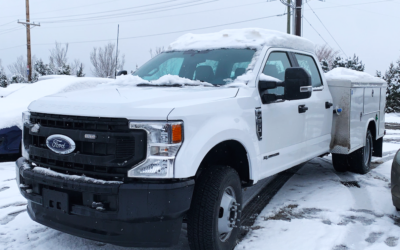How to Regain Control of a Vehicle in a Skid
Before we get started, let’s picture a scenario: A sudden and unexpected freeze descends upon your town. With a chill in the air and a layer of frost glistening on the world outside, you find yourself facing a daunting challenge — navigating icy, unplowed roads in the early morning darkness, all in the name of getting to work. As you cautiously approach an intersection and attempt to make a left turn, it happens: your tires lose their grip on the road, and you feel the unsettling sensation of your vehicle locking into a skid.
If you’re like most drivers, you’ve probably experienced something similar — especially if you live in a region where winter brings snow and ice. Over 70% of the nation’s roads are located in snowy regions, and, unfortunately, when you find yourself locked in a skid, it’s too late to try to figure out what to do next. That’s why it’s essential, before you ever hit the icy roads, to understand each of the different types of skids… and how to regain control in the event they happen.
Here, we’ll explore the various types of skids and show you how to navigate them successfully.
Rear-Wheel Skid
A rear-wheel skid occurs when the rear tires of your vehicle lose traction with the road surface. This loss of traction causes the rear end of your vehicle to slide out in one direction, while the front wheels continue in another. Here’s how to regain control of a vehicle in a skid involving the rear wheels:
- Remove your foot from the accelerator.
- Reorient the steering wheel so that it is pointed in the direction of the skid (this helps align your front and rear tires so that you can stabilize the vehicle).
- Countersteer if needed. This may be necessary if the wheels begin to slide in the opposite direction — continue to steer the vehicle back and forth until you feel the wheels regain traction.
- If you have antilock brakes, apply steady, consistent pressure (you will feel the brakes pulse as you do so). If you have standard brakes, pump them gently to prevent them from locking up.
Front-Wheel Skid
A front-wheel skid is a situation where your vehicle’s front tires lose traction with the road surface while the rear tires maintain their grip. In this scenario, the front of your car may start to veer off course, leaving you with limited control over its direction. To counter a front-wheel skid:
- Take your foot off of the gas.
- Release the clutch (if you’re driving a vehicle with a manual transmission) or shift to ‘neutral’ (if you are driving an automatic transmission and you know you can find ‘neutral’ without accidentally shifting into another gear).
- Resist the urge to steer immediately; it could make the skid worse. Instead, let the wheels slow the vehicle down as they regain traction.
- Once you can feel your front tires starting to regain grip, gently steer in the direction you want to go. It’s essential to make smooth and gradual movements, avoiding sudden jerks of the steering wheel. This will help you regain control without risking a spinout.
- After you’ve steered your vehicle in the right direction and your front tires have traction, put the transmission back into ‘drive’ (or release the clutch if you are driving a manual) and accelerate gently.
Getting Stuck in Place
Although not exactly the same thing as a skid (and certainly less immediately dangerous), getting stuck in place — such as in snow or mud — can still be a major inconvenience. This happens when your tires lose traction and are unable to move the vehicle either forward or backward. When it feels like your car is rooted in place, follow these steps:
- Don’t spin your wheels. Excessive wheel spinning can dig your vehicle deeper into the snow or mud, making it even harder to free yourself.
- Turn your steering wheel from side to side a few times. This action helps push the snow, mud, or loose material out of the way, creating a clearer path for your tires.
- Apply a gentle and controlled touch on the gas pedal. Avoid aggressive acceleration, as this can lead to further wheel spinning and dig your car even deeper into the muck.
- If you’ve got the time and the tools, use a shovel to clear away snow, mud, or debris from around your vehicle’s wheels and the underside of the car. This will improve your tires’ contact with the ground. You may also be able to increase traction by spreading kitty litter, gravel, or salt under your tires.
- If all else fails, rock the car back and forth — just be sure to check your owner’s manual first, as rocking may not be suitable for all vehicles and can potentially damage the transmission. If it’s safe to do so, shift from forward to reverse and back again, giving a light touch on the gas each time you’re in gear. This rocking motion can sometimes help the tires gain enough grip to get you moving.
No matter what situation you’re in, the best advice we can give on how to regain control of a vehicle in a skid is to stay calm. Pull your foot off of the gas pedal, make gradual steering adjustments, and try to work with the direction and momentum of the car to allow the tires to regain their grip on the road. And, if you’re not comfortable driving in slick conditions, pull over to the side (it’s better to be late to work than to get involved in an accident).
Want to learn more about safe driving and all things related to fleets? Read more at the Summit Fleet blog!






